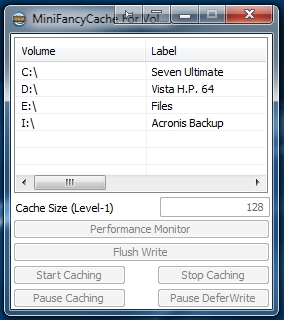

- #Like fancycache but free software#
- #Like fancycache but free free#
- #Like fancycache but free windows#
* LBW (Least Block Written): This L2 alogrithm is to achieve the least data written. When the L2 cache is full, the algorithm discards the data in both L1 cache and L2 cache first. * MBU (Maximum Block Usage): This L2 algorithm is to achieve the better cache capacity combined with L1 cache. Users shall notice this before decide to use SSD/Flash devices as Level-2 cache. Note: There might be a large number of swap data written to the cache, while SSD/Flash devices have limited write-cycle lifespan. When the L1 Cache is full, some data are transferred to the L2 Cache. The data are cached on system memory first. The access speed of system memory is higher than the OS Invisible Memory or SSD/Flash/Other device. Level-2 Cache: uses OS Invisible Memory or SSD/Flash/Other device as a secondary cache medium, supplementary to the system memory (L1 Cache). * Do not simultaneously run the programs which also manage the Invisible Memory.
#Like fancycache but free windows#
* Make sure that your Windows OS enables PAE feature. For NVIDIA chipset, it requires nForce 570 or above. Intel 945 chipset family and below are not supported. Normally for Intel chipset, it requires 946 chipset family or above. * Check if your hardware supports Invisible Memory feature at first. The program then shows the detected memory information.

Tick the checkbox “Enable OS Invisible Memory” in area ④. To use Invisible Memory, users need to globally enable it first. Need some tweaking to do since I also have Write Caching enabled in Windows. My fast and dirty C:\ CDM run ( cache size. * Supports volume/disk with proprietary file systemĪll runs below are on P67 with 2R0 X18-M G1 on SATA2 ports. * Supports caching for volumes or entire disks * Supports OS Invisible Memory and SSD (Solid-state Drive) as Level-II cache

* Supports Write-Through and Write-Deferred modes

* Supports caching strategies: Read/Write Caching, Read-Only Caching and Write-Only Caching * Supports LRU (Least Recently Used) and LFU (Least Frequently Used) cache algorithms
#Like fancycache but free free#
It's beta right now and is 90 day free trial. You simply enable portion of your RAM as a disk cache.
#Like fancycache but free software#
Just did and 4GB is definitely viable, especially for programs, browsers and such.Well, finally there's a poor man's software disk cache. RAMCaches do usually not change boot speeds as they activate ONCE the OS boots due to the program first launches inside the OS.Ĥb. Simply choose your OS drive or the preferred drive you want to cache and then go to Cache Size and type in the MB of RAM you want to allocate for use for the cache and afterwards click on Start Caching, then use a program like CrystalDiskMark to benchmark your new speeds (btw dont forget to turn the cache off once you are DONE, instead of turning the machine off, it MIGHT give problems, I haven't bumped into any but still better safe than sorry)Ĥa. Again using the utility/program/application Fanc圜ache will make it very easy for you to make a RAMCache. Yes RAMDrives are cleared upon reboot and nothing is "saved" although the utility saves it for you. It surely has for me, so I switched to Fanc圜ache.Ģ. The utility preferred would be Fanc圜ache (still in BETA but easy to use and still free), SuperSpeed the makers of SuperCache are MOSTLY for desktops, they have optimized their utility to work on desktops and making it work on laptops CAN cause problems. On my W860CU I reach speeds of 2K Mb/s, but on my MSi I reach speeds of 5K Mb/s (sometimes 7K Mb/s depending on what I cache).ġ. clearly my MSi is much faster due to the quality RAM I have (Corsair Vengeance). Both on my Clevo W860CU (w/ 8GB) and my MSi 1762 (w/ 32GB) and they are fast. I have a RAMCache setup w/ my 32GB of RAM in my laptop. Once you got beyond 2K Mb/s you can't feel any difference in speed. RAMDisk's/Drive's are not consistent and have insane speeds that are to the brink or reality.


 0 kommentar(er)
0 kommentar(er)
